What Exactly Is Feta Cheese?

Recently, Greek feta cheese has received a lot of attention thanks to its inclusion in a TikTok recipe for a one-pan pasta dish. While it's getting a lot of buzz these days for melting into a quick pasta sauce, the cheese certainly isn't new. Feta has a long culinary history in Mediterranean cuisine. It even appears in the Greek classic The Odyssey, written by Homer in the 8th century B.C., but the cheese is likely much older. While it's impossible to know exactly who made the first block of feta, it was probably a shepherd carrying milk that turned into cheese. Greek mythology tells another feta origin story. One story goes that Aristaios, son of the god Apollo, was sent to teach mere mortals the sacred art of cheesemaking.
Luckily, we don't need to know the historical origins to enjoy this crumbly cheese. Unlike other cheeses named for the region they come from, like Gouda, Asiago, and Camembert, feta is actually named for how it is served. The word feta is Greek for slice or slab because it's made in blocks and sliced. Let's look at what exactly feta is and how to make the most of this salty, flavorful cheese.
Read more: French Cooking Tricks You Need In Your Life
What Is Feta Cheese?
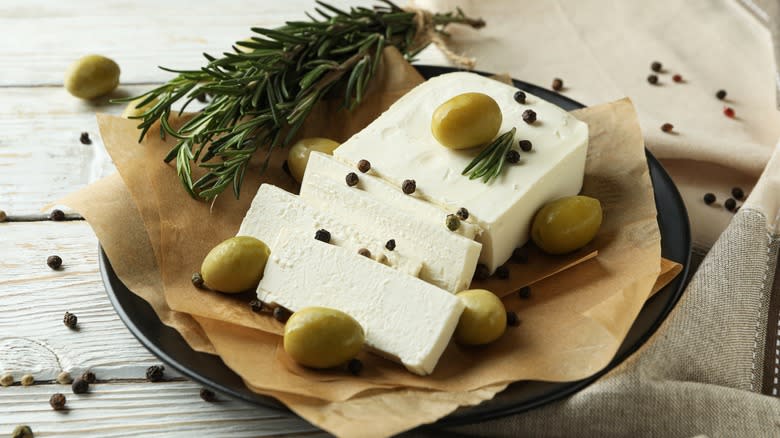
Feta cheese is a key ingredient in classic Greek dishes like spanakopita and orzo salad. But the cheese isn't just good in Greek food. It's versatile and perfect for any dish that needs a slight tanginess. Feta is a pickled curd cheese made from goat and sheep milk; there are variations of it, but traditional Greek feta has 70% sheep and 30% goat milk and must be made in one of seven distinct regions of Greece. These include Central Greece, Thrace, Thessaly, Macedonia, Peloponnese, and the Islands of Lesbos and Kefalonia.
Each region has its own variation of feta that varies slightly in taste and texture, due to each region's climate, animal breeds, and grazing habits. Feta from the coastal pastures of the Peloponnese feta tastes salty, with a hint of herbs and a creamy crumble. Feta from the mountainous regions of Macedonia and Thrace has a smoother texture and isn't as pungent. Feta produced in Lesbos is sweeter with a buttery taste and a soft crumbly texture, and feta made in Kefalonia is more acidic with a slightly grassy flavor. The feta from Central Greece and Thessaly is what most consider the classic Greek feta found in supermarkets, salty and with a tangy flavor. Even within each region, there is variation among cheese producers. To truly understand the nuances between regional variations of feta requires a trip to Greece.
How Is Feta Made?
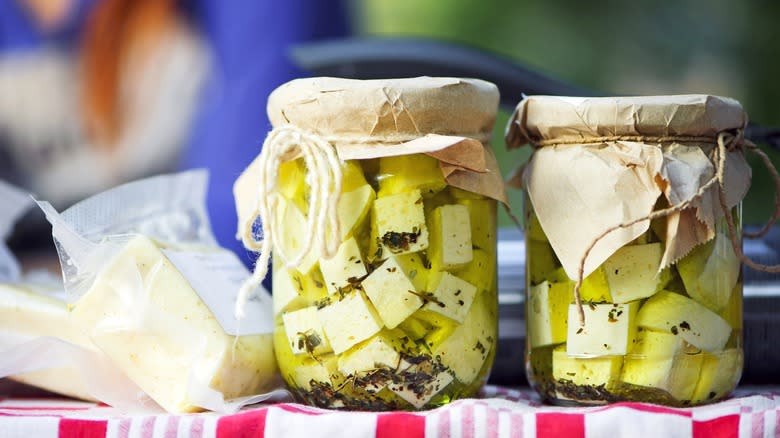
Surprisingly, the simple process of making feta hasn't changed much through the years. Aside from more modern equipment, Greek cheesemakers have kept the feta-making tradition. Feta starts with goat and sheep milk, casein, and rennet. When the mixture is heated and thickens, the curd is removed and placed in a mold to dry and firm up. Then, the curd is brined in salt to ripen and build flavor. The entire process takes roughly two months. Many home cheesemakers also start with feta as it's one of the easier cheeses for amateurs to master.
Greece isn't the only country that makes brined white cheese, but it's the only one that can legally call its cheese feta. True Greek feta was approved in 2002 by the Protected Designation of Origin (PDO), an organization within the E.U. that was created to protect and preserve the history and cultural status of foods. In the case of feta, it's a major accolate that sets Greek feta apart. While other Mediterranean and Eastern European countries make a similar product under the generic name "white cheese" or "table cheese," they are not feta. In the U.S., cheesemakers make feta-style cheese with cow milk.
What Does Feta Taste Like?
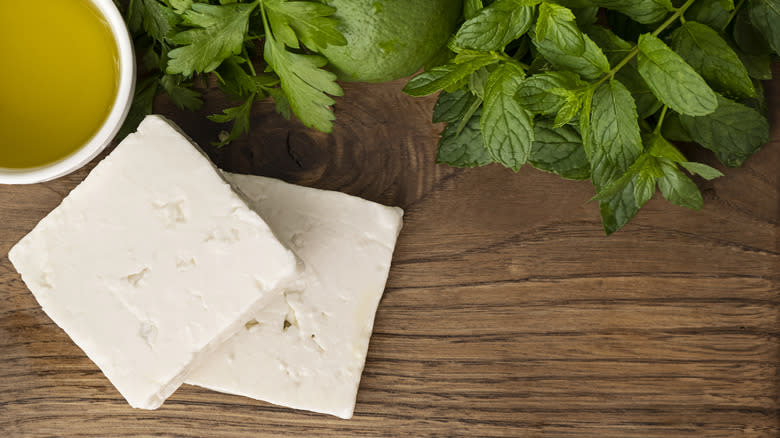
Feta has a salty, slightly tangy flavor, and its briny taste is the unique component that sets it apart from other milder white cheeses. The texture ranges from creamy and soft to dry and crumbly, depending on the type of feta. Feta is usually sold in a portion of brine to keep it fresh, but if the saltiness is too much, it's easy to make it less pungent by giving the cheese a rinse before cutting.
Traditional Greek feta has gamey undertones, mostly due to the diet of the goat and sheep. The native plants they graze on in the feta-producing regions have a significant effect on the product and the mouthfeel. Well-made feta with high-quality ingredients should melt in the mouth with saltiness but not feel crunchy or grainy.
Feta made with cow's milk loses some of the gamey aftertaste and has a milder overall flavor. The aging process still produces the tangy flavor, but it's not as intense as feta made with goat and sheep's milk.
How To Cook With Feta
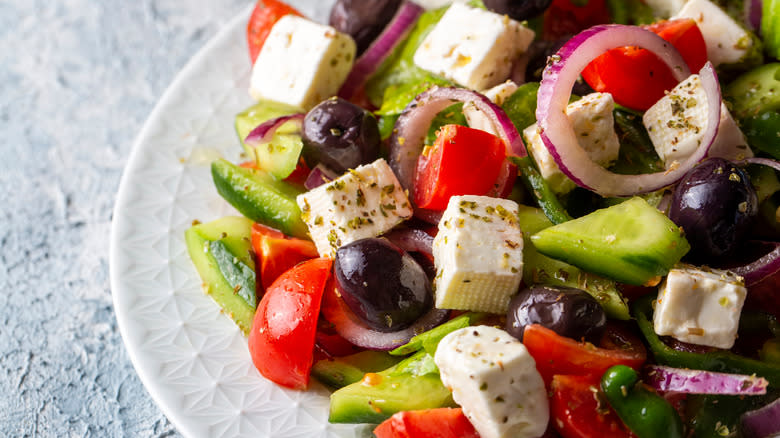
It's no surprise that feta is a key ingredient in many Greek dishes. It's a main ingredient in cheese pies made with flaky phyllo pastry like tiropita, or spanakopita where it's mixed with spinach, and it often appears on a mezze plate alongside olives and hummus.
There is no one way to cook with feta. The strong-tasting cheese can be used to enhance the flavor of other ingredients, like in a watermelon feta salad. The sweetness of the watermelon and its fresh, bright taste pair well with the creamy tanginess of feta. Since feta crumbles easily, it's often added to green salads or sprinkled on pizza and pasta. When paired with roasted vegetables, feta brings out the earthy umami flavor. But this cheese isn't just a garnish or a topper. It can be part of the main dish. For example, it can be melted into a sauce or dip. As an appetizer, warmed feta drizzled with honey is perfect on crackers.
Feta Vs. Mizithra Cheese
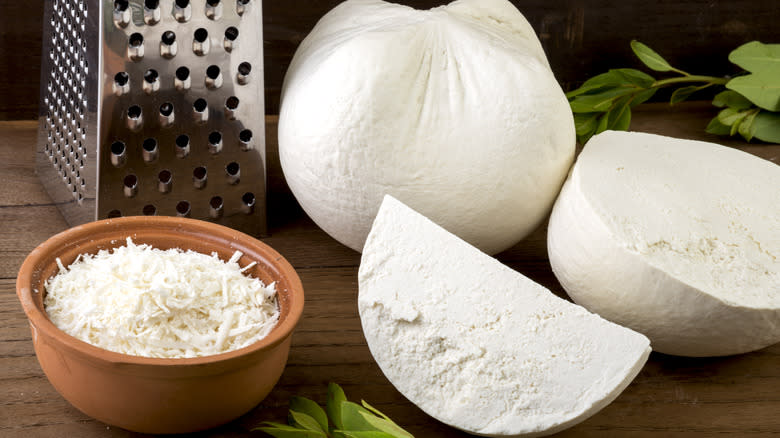
Mizithra, sometimes spelled myzithra, is a whey cheese from the Greek island of Crete, which shares some similarities with feta. Both cheeses are made from goat and sheep milk, and both can vary in texture. Mizithra can be soft, similar to ricotta in texture, or it can be salt-dried to make it into firm cheese suitable for grating and crumbling. While they may be placed next to each other in the supermarket, you should know the difference because these cheeses are not suitable substitutes for one another.
Mizithra is made from whey, which is the by-product of cheesemaking, and uses leftover whey mixed with goat or sheep's milk. The soft version can be fresh like a farmer's cheese or aged slightly for a sourer-tasting cheese. The soft versions are popular in desserts and pastries, while the dried version is used in savory dishes and doesn't melt well. The taste is more intense than feta, too. Even though they are both made with milk from the same animals, mizithra cheese is actually closer in taste and texture to aged Parmigiano Reggiano, with a dry texture and nutty undertones.
Feta Vs. Goat Cheese
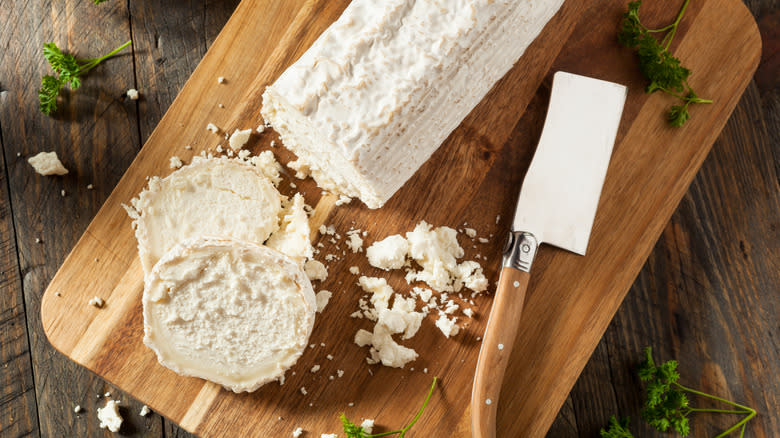
While feta is made from goat's milk, that doesn't make it a goat cheese. Goat cheese is usually made solely from goat's milk, which has a strong flavor due to its distinct mix of fatty acids. Since feta is only made with 30% goat milk, feta gets some of the tanginess of goat cheese but without the intensity of it. Both cheeses vary in texture. Fresh goat cheese is soft and a great spreadable cheese, but when it's aged, it becomes drier and has a more crumbly texture. Both cheeses can be consumed fresh or cooked.
Feta and goat cheese are both salted and brined, but goat cheese is usually not sold with the brine. Instead, it's often formed into logs and may have an edible rind-like covering. Both cheeses can be used in sweet or savory dishes. One thing that sets feta and goat cheese apart from other cheeses is that they are lower in lactose than cheese made with cow milk. Some people who are lactose intolerant can still enjoy both goat cheese and feta in moderation.
Feta Vs. Halloumi
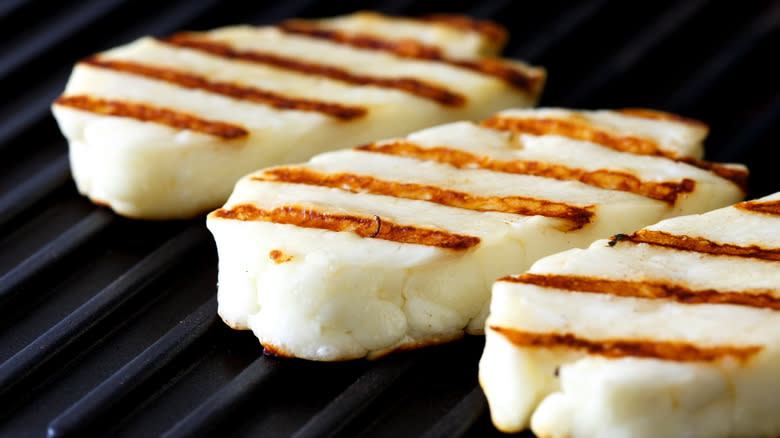
Halloumi cheese often gets mislabeled as Greek cheese because it's a mainstay of Greek cuisine, but it actually comes from Cyprus. Feta and halloumi have some similarities, such as both being salty curd cheeses made from a mix of sheep and goat milk, but that's about all they have in common. Halloumi is made by heating the curds and then placing them in a brine. The process gives the finished cheese a high melting point, meaning that halloumi can be cooked by grilling or pan-frying. Traditional preparation of halloumi has a small amount of mint leaves added for a slightly minty taste, so it's not uncommon to find little green specks in store-bought halloumi; that's how, you know, it's traditional. The texture of halloumi is also different to feta, being closer to Canadian cheese curds, and can be described as squeaky cheese.
Halloumi has a stronger flavor profile than feta; it's saltier and tangier. Both feta and halloumi can be cooked, but feta will become creamy and melty while halloumi keeps its shape. One key difference is that feta can be eaten straight from the package, while halloumi is usually cooked in some form. Nutritionally, the cheese varies, too, as halloumi has a higher fat content and more protein than feta.
Where To Buy Feta
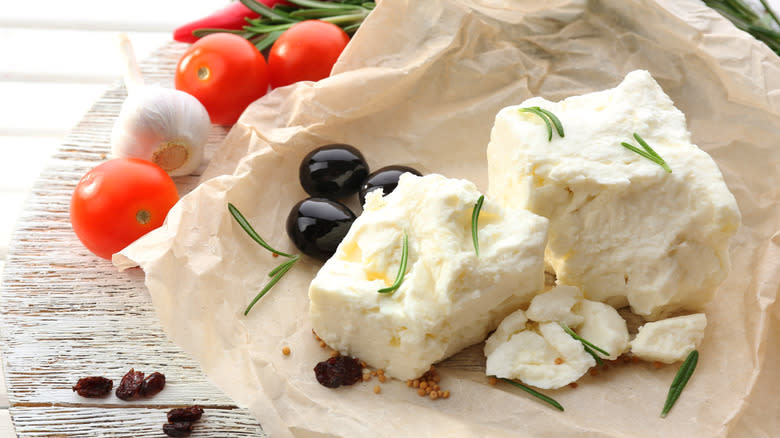
Most supermarkets or international stores sell feta, but you'll need to check the label to see if it's PDO-certified Greek feta or a version of feta-like cheese. Imported Greek feta is more expensive than the imitations and you can usually buy it packaged in brine. This keeps the feta from drying out and helps the flavor. Some international stores sell feta that's been vacuum-packed. Once opened, it is best to store it in a simple brine with two teaspoons of salt and one cup of water.
Many stores sell feta crumbles. Usually the least expensive form of feta, these may be made with a mix of cow, sheep, and goat milk, although some companies use only cow milk mainly because it's more cost-effective and widely available. The most important thing when buying feta is reading the labels. If you're looking for a crumbly cheese to sprinkle on pizza or a salad, then feta-like cheese is an economical way to do so. On the other hand, if you're making a classic Greek dish or plan on feta being the star of the show, like in an appetizer or as part of a charcuterie board, then it's best to buy the real deal for the best flavor of Greek feta.
Nutritional Information For Feta
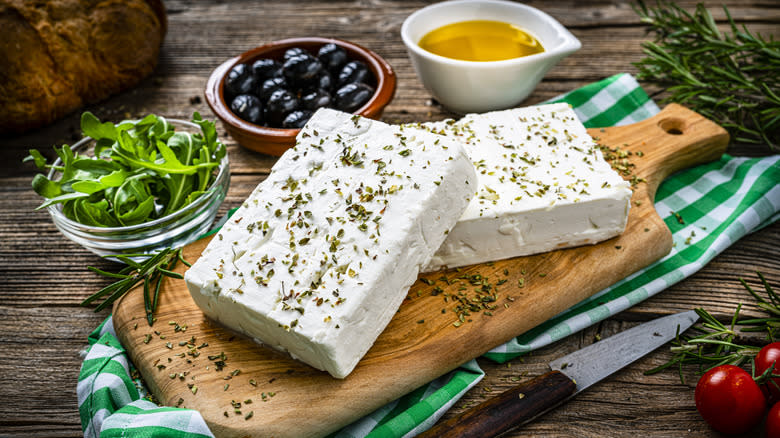
Cheese doesn't normally make the list of healthy foods, but feta is no ordinary cheese, and it is considered a healthy option. It's is rich in calcium and high in protein. Compared to other cheeses, it's also lower in fat and calories. According to an article in the International Journal of Food Microbiology, feta contains the microbe Lactobacillus plantarum, a probiotic with anti-inflammatory properties that can also promote a healthy gut. Unfortunately, this healthy Mediterranean cheese has a downside: It's high in sodium. So, if you want to lower your sodium intake, it's a good idea to enjoy feta in moderation.
One interesting thing to know about feta is that it's a dietary source of tyramine, a compound created by the breakdown of the amino acid tyrosine. Some people are sensitive to tyramine, and Migraine Now explains that it can trigger migraines. However, since migraine triggers vary from person to person, it takes trial and error to find out which tyramine-containing foods to avoid.
International Varieties Of Feta

Greek cheesemakers can thank Denmark for getting their PDO status because Denmark was calling its white cheese feta, which is how the legal dispute over the name started. But in fairness, other countries besides just Denmark have been making cheese similar to feta for a long time, and these countries still make their versions of white feta-like cheese under a different name with flavor and texture variations.
The Danish version is made with cow's milk and is smooth and creamy with a sour, tart flavor; it's like a cross between sour cream and cream cheese. French feta is made with only sheep's milk, specifically the same breed of sheep used to make the classic French cheese, Roquefort. It isn't as salty as Greek feta and has a creamy texture. American feta is made from cow, sheep, or goat milk and has a mild taste and dry crumbly texture. Bulgaria, meanwhile, skips the "feta-like" label altogether, calling its dense cheese "Sirene" with a PDO certification of its own.
How To Store Feta
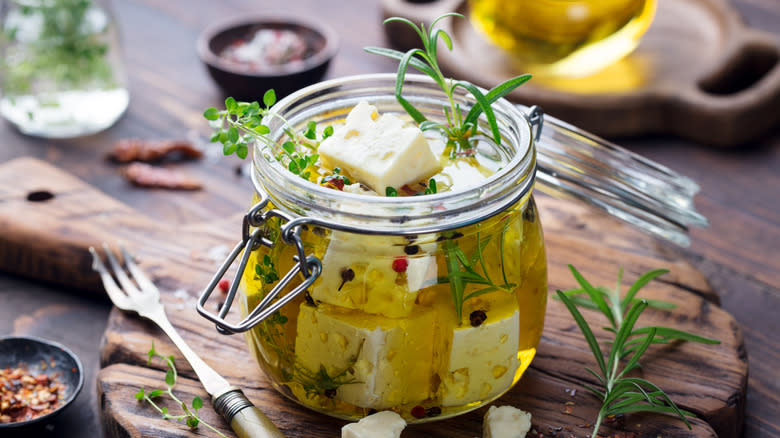
Feta, like most cheese, needs to be properly stored to keep mold and harmful bacteria at bay. There are a few ways you can store feta. Greek feta in brine can be left in its original packaging. If the brine starts to smell funky, you can pour it out and make a simple saline solution. Just make sure to rinse the feta block before placing it in the new brine and keep the feta completely submerged. Another way to store feta is to cut the block into pieces and place them in a jar, then cover it with olive oil and seal the airtight lid. The oil protects the cheese and doesn't affect the flavor. For extra flavor, you can also add herbs to the oil to flavor the cheese too.
There's some online debate about whether you can store feta in a milk bath. Some claim it keeps the feta moist, and that's how they do it in Greece, and some recommend using salted milk. This method is best if you'll be using the feta within a few days, but if you won't use it quickly, then a brine bath is a better option. Technically, it is also possible to freeze feta, but this will alter the texture. If you plan on freezing it, make sure to wrap it tightly in plastic wrap and then place it in an airtight container. Thaw the feta on the counter or in the refrigerator before using it.
Read the original article on Daily Meal.
